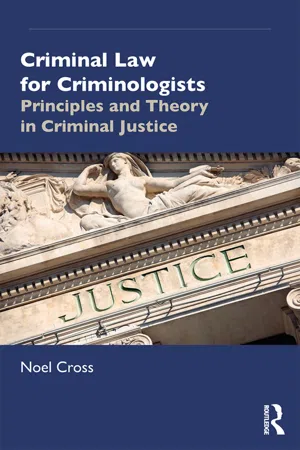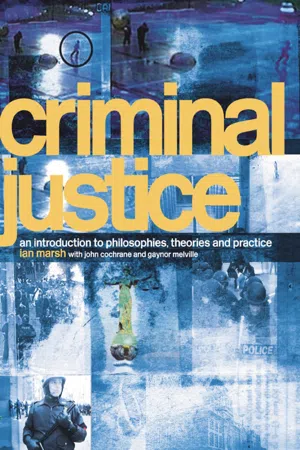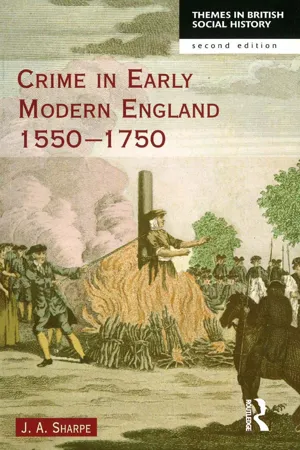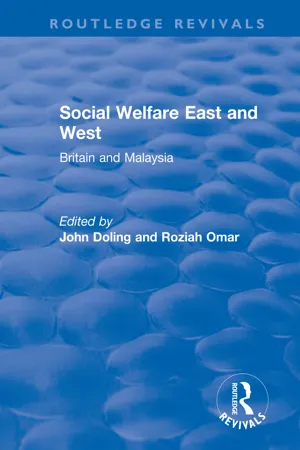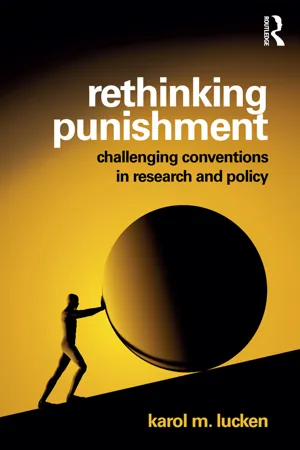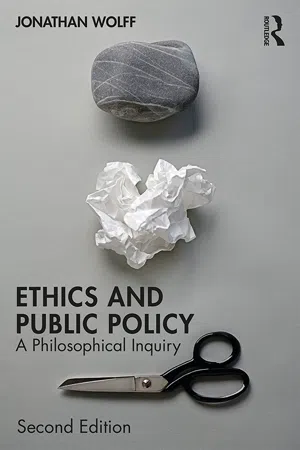History
Crime and Punishment in Britain
"Crime and Punishment in Britain" refers to the historical evolution of laws, law enforcement, and judicial systems in Britain, as well as the corresponding methods of punishment for criminal offenses. This encompasses changes in legal codes, the development of policing, and the implementation of various forms of punishment, including imprisonment, fines, and capital punishment, reflecting shifts in societal attitudes and values over time.
Written by Perlego with AI-assistance
Related key terms
10 Key excerpts on "Crime and Punishment in Britain"
- eBook - ePub
- Tim Newburn(Author)
- 2017(Publication Date)
- Routledge(Publisher)
What is Criminology?, Oxford: Oxford University Press.Passage contains an image
Chapter outline
- Introduction
- Emergence of a modern criminal justice system
- Policing
- The 'new police'
- Resistance and reform
- Into the twentieth century
- The victim and prosecution
- Formalisation of the prosecution process
- The courts
- Decline of the profit motive
- Punishment
- Capital punishment
- Transportation
- Imprisonment
- Probation
- Policing
- Crime and violence in history
- Levels of crime
- Perceptions of crime
- Questions for further discussion
- Further reading
- Websites
2 Crime and punishment in history
Chapter Summary
In this chapter we take a longer historical look at crime and punishment. The aim is to provide a historical overview of the origins and development of many of the other subjects you will encounter the rest of the book. As such, we will look at the origins of the modern criminal justice system and changes in our understanding of crime from pre-modern to modern times and, more particularly, at the emergence of modern, formal police forces. The changing nature of punishment will be explored by examining the growing role of imprisonment as a key response to crime as the use of both capital punishment and transportation declined. We then turn to the changing role of the victim, in particular in relation to the prosecution process, and also ask what is known about levels of crime in British society prior to the introduction of criminal statistics, and how attitudes towards, and perceptions of, crime have changed in recent centuries. Finally, we ask to what extent it is possible to estimate levels and trends in crime in previous eras and, perhaps most intriguingly, whether we appear to be becoming a more or less crime-ridden society.Introduction
There are numerous reasons why we should study the history of crime, but here we will stick with two of the more important. First, it is hard to understand contemporary systems and trends without some grasp of how things were organised in previous eras. Thus, an appreciation of systems of punishment in previous periods may help provide a better understanding of how we organise our contemporary penal system. A study of the history of crime can do this through the simple process of providing a contrast. By examining systems that are different from those we are used to, we may be encouraged to look at our current practices in a new light. Comparative research across differing jurisdictions, but within the same historical period, involves a very similar process. Furthermore, unless we have some grasp of history, we are unlikely to be able to understand the aetiology - eBook - ePub
Criminal Law for Criminologists
Principles and Theory in Criminal Justice
- Noel Cross(Author)
- 2020(Publication Date)
- Routledge(Publisher)
The transformation of various forms of previously legal customary behaviour into crimes punishable by death through the ‘Bloody Code’ of the 18th and early 19th centuries (Hay 1975) is a key example of differing viewpoints on the definition of crime at different levels of society in England. As a result, the reliability of criminal statistics from the past is always limited in terms of giving a full and complete picture of crime, just as today’s crime statistics are. Finally, it is important to remember that records of prosecutions and convictions in court almost certainly do not give us an accurate measure of how much crime there was in society at a particular time (Sharpe 2014; Godfrey et al. 2008: 48). There was a ‘dark figure’ of unrecorded crime in the past, just as there is today (see Chapter 3 for more discussion of this issue in relation to actus reus). The remaining sections of this chapter, while taking the limitations of historical crime data into account, look at knowledge and perspectives on criminal law and justice as they operated in the past in England. Perspectives on the history of criminal law in England Johnstone and Ward (2010) argue that before the emergence of a centrally organised system of criminal law, village-style communities regulated what we would now see as being criminal behaviour on a local basis, and the response taken depended on whether the crime took place between community members or between strangers. Local communities dealt with crime in a wide variety of ways, ranging from verbal warnings to exclusion from the community and death (ibid: 31). Violent acts of vengeance were more common as a response to crimes committed by strangers, as a means of maintaining honour and meeting social obligations between lords and their followers (Berman 1983) - eBook - ePub
Criminal Justice
An Introduction to Philosophies, Theories and Practice
- Ian Marsh, John Cochrane, Gaynor Melville(Authors)
- 2004(Publication Date)
- Routledge(Publisher)
Chapter 3 ) demonstrates that there have been attempts to reform criminals but they have not detracted from the general motif of punishment as needing to be severe and exemplary. Reform and rehabilitation as ‘aims of punishment’ gained perhaps their widest support in the late 1950s and 1960s, providing a different sense of purpose for punishment and leading to a general optimism about the possibilities of punishment. This was reflected in various new methods of punishment introduced in Britain and elsewhere in this period, including parole, suspended sentences, community service orders and day training centres. The optimism of the 1960s soon gave way to a more sceptical perspective: rising crime rates and high rates of reoffending led to criticisms of the new methods of punishment as being too soft. The emphasis moved away from reform, with senior politicians advocating a hardline approach to punishment that was reflected in ‘short, sharp shock’ sentences being introduced in the early 1980s, and more recently the introduction into Britain of policies based on American ‘boot camps’ and ‘three strikes and out’ policies.However, these newer, harsher initiatives have similarly had little effect on the size of the prison population or on rates of recidivism. Without going into great detail, some overall figures will help illustrate the pressures on the prison system in Britain and provide a context for considering the different philosophies of punishment. The prison population in Britain has continued to rise pretty steadily over the past few decades, with over 71,000 people in Prison Service establishments in 2002 (Home Office data, Social Trends 33, 2003). The number of people given immediate custodial sentences in 1999 was over 105,000 compared to just under 80,000 four years previously (Home Office data, Annual Abstract of Statistics, 2002). (The reason that the number of people sent to prison each year is greater than the prison population is that most prisoners are sentenced to short sentences of less than one year and so not all would be in prison when the annual figure is calculated.) As regards repeat offenders, it would seem that a relatively small number of offenders are responsible for a large proportion of offences. Of the 97,800 males who entered prison in 1999, almost 68 per cent had had previous convictions for ‘standard list offences’ (which include all indictable offences plus some of the more serious summary offences), with 46 per cent having had three or more previous convictions (Home Office data, Annual Abstract of Statistics - eBook - ePub
- James A Sharpe(Author)
- 2014(Publication Date)
- Routledge(Publisher)
CHAPTER EIGHTContinuity and Change in Crime and Punishment 1550–1750
In the previous chapters we have ranged freely over a number of areas, and have demonstrated, if nothing else, the variety of approaches that can be employed in studying the history of crime, and the multiplicity of issues involved in the subject. The point has now come for pulling these various threads together, and attempting to understand the general developments and problems relevant to the study of crime in our period. These developments and problems are fairly numerous, and the avenues towards understanding them correspondingly diverse. There is, nevertheless, one essential central theme: that of the possible connections between patterns of crime, patterns of punishment, the attitudes of ruling groups to such matters, and broader socio-economic change. After all, a general consensus suggests that such connections exist: thus a student of crime in Victorian and Edwardian Britain, for example, could claim that‘it has become one of the more widely accepted axioms of our age that an increasing crime rate is the invariable price of material progress’.1 Commentators on earlier periods have, in general, been equally convinced of the presence of such links. Hence the author of a general work on crime in early modern Europe informs us that ‘although crime is usually seen as an index of social distress, it can also be appreciated as an index of social development’, claims that the pattern of European theft, if drawn up, would correlate in time and geography with economic development, and suggests that within the timespan he covers Europe witnessed ‘the emergence of new forms of criminality that reflected the ongoing transition to industrial life’.2 - eBook - ePub
Criminal Justice Theory
An Introduction
- Roger Hopkins Burke(Author)
- 2013(Publication Date)
- Routledge(Publisher)
6 Punishment in Modern SocietyThis chapter discusses the philosophy and theory of punishment in modern societies and locates this debate in the context of the four models of criminal justice development that provide the theoretical underpinnings of this text. It is important to remember that all too often punishment is considered to be a distinct and separate entity from the understanding of penology but it is impossible to legitimately understand one without the other, for imprisonment is, next to capital punishment, the harshest and certainly one of the most commonly used sentences. Without the acknowledgement of penal realities, justifications for punishment become mere intellectual debate. Trying to make sense of familiar concepts such as ‘making the punishment fit the crime’, is not strictly a theoretical question and these are not just philosophical matters of concern to academia. These questions have great practical relevance within the criminal justice process generally and the penal system specifically. By bringing the two together, locating penal trends in theory, and grounding theory in policy, the totality becomes greater than the sum of its parts.According to an old Muslim legend, there was once a rich king who left his servant in charge of his kingdom and in receipt of his riches, while he went on a long journey. Upon returning to his kingdom he found to his dismay that his servant had stolen some of his treasures. The rich king took the servant in front of the judge for sentencing. The judge ordered that both the servant and the king should be punished; the servant because he had broken the law, and the king because, by leaving such a great temptation in the hands of a person with so few possessions and possibly weak character (both realities which the king should have been able to assess), the king was in fact causing the man harm (Ellis and Ellis, 1989). - eBook - ePub
Social Welfare East and West: Britain and Malaysia
Britain and Malaysia
- John F Doling, Roziah Omar(Authors)
- 2017(Publication Date)
- Routledge(Publisher)
12 Crime and penal policy in Britain MIKE NELLIS DAVID STEPHENSONIntroduction
Rhetorically at least, official policy towards offenders throughout the twentieth century in Britain has been concerned with reformation and rehabilitation, although in practice, in the sentencing philosophies of the courts and the administration of the penal institutions (at least for adults), retribution and deterrence have never been wholly supplanted. The meaning of reformation and rehabilitation has in any case changed over time. They were originally conceived of in moral terms, exhorting offenders to live by the precepts of the Christian faith, and sometimes offering them basic practical assistance to do so. This emphasis began to be supplanted by psychology and sociology in the 1930s, and the period between the 1950s and the 1970s became the high-water mark of official commitment to 'scientific rehabilitation'. During this period criminology expanded as a university subject at postgraduate level, initially taking forward a government-based research agenda into the causes of, and solutions to, crime. Influenced by radical theoretical developments in sociology, however, criminology became an independent academic discipline, prepared to criticise official policy, and has remained so despite the decline of the rehabilitative ideal in the 1980s and 1990s.The breadth and complexity of the ways in which crime and criminal justice are now studied in Britain, the abundance of data and the diversity of perspectives, is perhaps the first major difference with Malaysia. This imbalance makes the comparative criminological task (Nelken, 1997) unusually difficult, so this chapter is perhaps best seen as a precursor of proper comparative work, rather than an instance of it. It concentrates on key features of criminal justice policy in Britain in the past ten years, but will occasionally refer back beyond this period to illuminate (from the British side) why measures such as corporal and capital punishment which continue to be used in Malaysia were discontinued in Britain. It will seek to acquaint Malaysian readers with some of the issues which preoccupy British criminal justice policy-makers, and professionals, and their critics at the beginning of the 21st century. - eBook - ePub
- Barry Godfrey, Graeme Dunstall(Authors)
- 2013(Publication Date)
- Willan(Publisher)
Chapter 3
Explaining the history of punishment
John PrattAfter inviting me to give a seminar on my work to a local criminology society meeting, a colleague later introduced me to the audience as ‘an armchair academic’. In their mind, because I had been engaged in historical research, it was as if what I was doing was some sort of esoteric but largely irrelevant luxury. Happily, I am certain that this depressing view of the parameters and possibilities of criminological research is idiosyncratic to that person rather than normative of the discipline as a whole. Indeed, as I show in this chapter, the history of punishment has demonstrated an exhilarating expansion and fortitude over the last three decades or so. Not that it was always like this, though. There had been a dearth of historical scholarship before then. Why this might have been so, how and in what ways the history of punishment has become such a dynamic subject since that point, and how our understanding of the purposes and nature of historical inquiry have changed will be the main themes of this chapter.The contribution of Radzinowicz
Sir Leon Radzinowicz (1948: ix) began the preface to what ultimately became his monumental five volumed History of English Criminal Law with the statement that:Lord Macauley’s generalisation that the history of England is the history of progress is as true of the criminal law of this country as of the other social institutions of which it is a part. Child of the Common Law, nourished and moulded by statute, the criminal law of England has always been sensitive to the needs and aspirations of the English people, and it has continually changed under the impact of the predominant opinion of the day. - eBook - ePub
Rethinking Punishment
Challenging Conventions in Research and Policy
- Karol M Lucken(Author)
- 2017(Publication Date)
- Routledge(Publisher)
Punishment’s meaning can also be derived through frameworks that have no one author, source, official name, or even stated definition of punishment. What I call a legal and social control framework has been cultivated from various legal and scholarly perspectives as well as popular notions of punishment. A legal framework reflects the popular notion of punishment as well as the meaning of punishment conferred by the U.S. Supreme Court. Within this framework, punishment is largely allied with conventional forms (e.g., prison, probation, parole, death penalty) and philosophical functions (e.g., deterrence and retribution). A social control framework reflects a uniquely academic perspective. Within this framework, the many attributes and mutations of the control apparatus are fully observed.What is punishment? A legal framework
A legal framework employs conventional benchmarks for defining penal activity. Therefore, punishment’s meaning is roughly conceived as a legally authorized state reaction to criminal behavior for the purposes of retribution, rehabilitation, or deterrence. Apart from the death penalty, this commonly accepted notion of punishment is equated with the “tough old-fashioned” (Van Swaaningen, 1999: 24) sanctions of prison, probation, parole, and jail. In fact, the construction of punishment through the pairing of these purposes and sanctions is nearly automatic in the public and political arena, criminal justice texts, and government reports and statistics. Annual and other routinely disseminated reports on punishment rates, using federal or state PPPJ populations, exemplify and reinforce this conventional meaning.This conception of punishment appears to have been affirmed in two fairly recent U.S. Supreme Court rulings. The practices prompting these constitutional reviews were sex offender civil commitment (SOCC) and registration-notification (SORN).1 - eBook - ePub
Foucault - The Key Ideas
Foucault on philosophy, power, and the sociology of knowledge: a concise introduction
- Paul Oliver(Author)
- 2010(Publication Date)
- Teach Yourself(Publisher)
There was also a changing sense of morality in society. Offences were seen rather less as crimes against government, authority or those in power, but rather more against the nature of society itself. A criminal offence was a crime against other citizens, against one’s neighbours or community. Crime was a social offence and it was necessary for the punishment to be viewed as appropriate to the offence. There thus developed a social morality where different types of crime were viewed as more unethical than others.InsightTowards the end of the eighteenth century crimes began to be evaluated in terms of the extent of their negative effects on society, and the extent to which they reduced the cohesion of society. For instance, one element of such social cohesion was that people should work hard and gain from the proceeds of that hard work. Theft was seen to be serious because it undermined the advantages of hard work.In the new social context of crime, citizens demanded a form of legal fairness in the evaluation of the likely guilt or innocence of someone. If this was not so, then an innocent person could easily be found guilty of a crime they did not commit. New rules and standards for the assessment of evidence were developed in order to be able to judge someone objectively and fairly. We are familiar in modern times with the way in which certain types of crime are grouped together and attract a comparable type of punishment.So used are we to the logic of this type of judicial and legal system, that we perhaps take it for granted. Yet it was in the nineteenth century that we began to see the emergence of this type of system. The notion that ‘the punishment should fit the crime’ began to emerge as a rational system.Foucault emphasized that ‘detention and imprisonment do not form part of the European penal system before the great reforms of the years 1780–1820’ (Rabinow, Michel Foucault: Ethics , p. 23 - eBook - ePub
Ethics and Public Policy
A Philosophical Inquiry
- Jonathan Wolff(Author)
- 2019(Publication Date)
- Routledge(Publisher)
6CRIME AND PUNISHMENT
§Introduction
Among the concerns of the British public, crime – or perhaps law and order – always features near the top of the list. Yet it is worth pausing to ask the question: ‘what is so bad about crime?’ This, clearly, is rather provocative. If asked in the spirit of an economist one would expect the answer that, when we look into it, crime isn’t such a bad thing after all. Karl Marx ironically remarked on what would now be called the ‘technology-forcing’ aspects of crime. The need for secure locks led to developments in precision engineering which no doubt had many beneficial applications elsewhere. As Marx says, ‘Doesn’t practical chemistry owe just as much to the adulteration of commodities and the efforts to show it up as to the honest zeal for production?’ and ‘Torture alone has given rise to the most ingenious mechanical inventions, and employed many honourable craftsmen in the production of its instruments’ (Marx 1969 [1863], 387). Crime prevention – not to mention the academic study of crime – is a major enterprise and in this way contributes to economic growth and national wealth, albeit the growth of something that detracts from, rather than adds to, human happiness.Crime prevention, in fact, is an excellent illustration of the point that economic activity is not necessarily a good thing in itself. Crime, we know, is something we would rather be without even if it can have some consequences that are useful for some people. Crime is so bad that we punish people, often with imprisonment, if we find them guilty. In this respect crime is almost unique. Apart from severe cases of mental illness or infectious disease, in a liberal society there is no other reason that we take as sufficient to deprive people of their liberty, however irritating they may be. Many philosophers and legal theorists have looked at the question of the moral justification of punishment, and we will follow this up later on in this chapter. Yet to understand the point of punishment, and its possible justifications, we need first, presumably, ask why we find crime so troubling. And that is what we shall explore in the first part of this chapter.
Learn about this page
Index pages curate the most relevant extracts from our library of academic textbooks. They’ve been created using an in-house natural language model (NLM), each adding context and meaning to key research topics.

